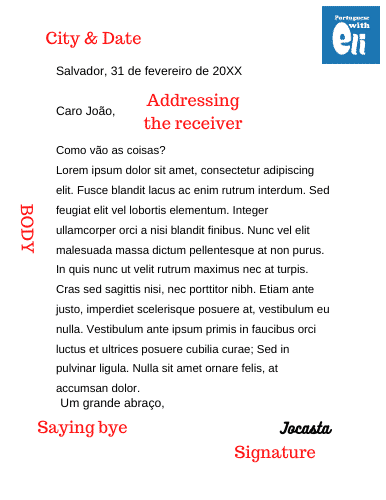(Almost) Everything about How to Write a Letter in Brazilian Portuguese

Why would someone worry about how to write a letter in Portuguese?
In 2011, a Brazilian journalist (Alberto Villas) asked, “who still writes letters?” in his column.
And as is usually the case with questions like that, the asker also provides an answer.
And his answer was, “nobody.”
Wow. How surprising he would answer nobody.
The author makes some good points. But people tend to declare something is dead or something is not used anymore even without having researched into the matter.
For letters are alive in Brazil.
Perhaps not so much as they were before the Internet came by. But they are there. All you need is to look.
Only in Minas Gerais, 3.4 million letters were delivered in 2014. That corresponds to 33% of everything that was posted that year.
And one of the trends that are becoming more popular in Brazil is having penpals.
So, although you won’t write a letter for the same reasons as you would in 1995, you can still exchange correspondences with people in Brazil.
Perhaps your family?
Writing to People You don’t Know — Formal Letters
If you do business in Brazil and ever need to write someone an official or formal letter, you have to follow our structure.
And of course, the vocabulary changes according to some criteria.
Do You Already Have an Established Relationship?
In that case, you can use the following suggestions to open your letter:
- Senhor, senhora. Sir, Madam.
- Caro, cara. Dear.
- Prezado, prezada. Dear.
- Caro(a) doutor(a)… dear doctor.
- A quem possa interessar. Whomever it may interest.
Doctor is used when addressing lawyers, judges, and other “important” people. It dates back to the Empire of Brazil. D. Pedro passed a law that made the term “doutor” mandatory when talking to people who studied Law.
Since then, it has only become more popular.
Is This the First Time You’re Writing to This Person?
Here, you should be a bit more careful with your words.
The first contact is crucial. You want to give a good impression.
Stick to the suggestions below.
- Prezado doutor(a) … Dear doctor.
- Excelentíssimo (a) senhor(a)…Extremely excellent sir.
In this case, we usually insert the receiver’s full name.
What Should I Call You? How to Address People You Don’t Know.
If you want to know how you would address authorities and important people in the world, check out this article.
It’s in Portuguese and it lists all of the important vocabularies you need when you write a letter to the president 🙂
(As if that happened every day.)
Closing A Formal Letter
Depending on where you are — Brazil or Portugal — you need to resort to different words.
The ones you’re about to see here make sense in Brazil.
As I have never personally done any business in Portugal or with Portuguese people other than some online work, I can’t guarantee these are valid there too.
- Atenciosamente. Best regards.
- Saudações cordiais. Best regards.
- Com os melhores cumprimentos. Best regards.
- Grato. Thank you.
- Agradeço desde já. Thank you in advance.
- Aguardo sua resposta. I’ll be waiting for your reply.
- Respeitosamente. Respectfully.
And a quick note:
If the expressions have a similar translation, the further down the list you go the more formal the expression becomes.
Writing to People You Have a Relationship with — Familiar Letters
When you’re writing a letter to a friend or a pen pal — maybe someone you met on Slowly — you should keep in mind it’s a dialogue.
And since it’s a dialogue, you should refer to something that you and the other person know. And you need to use the first person, that is, write it from the perspective of “I”.
And letters in Brazilian Portuguese follow a set structure.

And take a look at that picture above again.
We have some rules for placing those elements in the letter.
Place and Date
Remember to insert this piece of information. If you are sending snail mail, it will take some time until it arrives to its destination.
It is good to know when it was sent so the reader has a clear perspective of what was going on at the time of your writing.
Vocativo
I’m going to use the Portuguese word for that.
It simply how you will start your letter — what formula will use to address the other person.
Common ways to address a friend are:
- Oi, fulano. Hi, So-and-So.
- Querido fulano. Dear So-and-So.
- Caríssimo. Dearest (old fashioned)
We usually insert a comma after the vocativo; in more formal letters we can also use a colon.
Body of the Letter
The title here is self-explanatory.
It’s the bulk of your message. It’s where you write what you want to write.
When writing to friends and family, we usually employ some formulas.
- Tudo bom? How are you?
- Como estão as coisas…? How are things going?
Closing
The Portuguese word for this is “fecho”.
If you’re writing to someone you know, you can use any of the words below to take leave of somebody.
- Abs. Hugs.
- Abraços. Hugs.
- Bjos. Kisses.
- Beijo. Kisses.
- Até (mais)! See you (soon)!
- And Brazilians are very warm people.
Personal relationships are very important to us.
We make strong bonds with other people. It doesn’t matter if they are coworkers, neighbors, or relatives.
We try to be as close as we can.
That might come off as a bit odd to you if you’re not used to that kind of closeness.
But you can take it from me that you do need to learn how to live with it.
Because it influences everything. Even how we close a letter.
(But in time — if you don’t know the person, don’t end your letter by saying “kisses”. It might be a bit too much.)
Signature
Well, do I need to explain?
But if you speak Spanish, assinatura is signature; the Spanish word relates to school subjects.
Sending Letters in Brazil — What to Write on the Envelope?
I’ve sent some letters abroad before. Writing the address was a pain because it wasn’t similar to what we have in Brazil.
When you are sending someone a letter in Brazil (even if you are abroad), you need to follow the order that is recommended by the official post office.
- Receiver’s name.
- Street, number, CEP (the Brazilian ZIP Code)
- Additional information (apartment, building…)
- City, state abbreviation, Brazil.
So, if you are writing a letter to José da Silva who lives in Salvador, here is how you would write it.
- José da Silva.
- Av. dos Bois, 123, CEP 40000-000.
- Bairro Tal e tal, próximo de tal, apartamento 123
- Salvador, BA, Brasil
And don’t forget to write your address on the front part of the envelope.
If for whatever reason your letter cannot be delivered it will return to you.
Does That Apply to Email Writing in Portuguese?
To a large extent, it does.
We do away with place and date for obvious reasons (the email takes care of that).
And we simplify some structures depending on the person we write to.
Emailing in the Workplace — People You Know
You don’t need to complicate matters here.
When you already know the person you are writing to — a known client, a vendor you already talked with — you can use a simple “olá.”
But if you don’t feel well acquainted with this person yet, you can use either one of the two formulas below.
- Olá…
- Caro… Dear.
- Prezado… Dear.
And the word “prezado” comes from the verb “prezar,” to value. This is a more formal verb.
“Caro” is the adjective for expensive. But it also translates as dear.
Emailing in the Workplace — People You Should Know but Don’t
You would use basically what you would use for letters too.
- Prezado doutor(a) …
- Excelentíssimo (a) senhor(a)…
But when I was an office worker, I never used those expressions.
Some vendors were more uptight about it and would write those pompous titles in their correspondence. But I never did and nobody ever complained.
How about the Attachments?
This is a big problem.
Brazilians usually don’t know how to refer to attachments that they include in emails.
If you want to test this, just ask any of your friends how they would translate:
“You’ll find the report in the attachment below.”
But luckily we have some formulas and simple explanations.
Em anexo
This is an invariable expression.
- O documento está em anexo.
Anexo, Anexa
When you write “anexo”, you have to remember that it’s an adjective and should agree with the noun it refers to.
- A fotografia anexa a este email.
- O relatório anexo a este email.
No Anexo
Now the word anexo has become a noun.
You should use this expression if you’re referring to a specific piece of information found inside one of the attachments included.
- Encontre os dados bancários no anexo.
Do Brazilians Use Emails?
They are popular, but not as popular as in other countries.
According to this website, 52% of Brazilians spend at least one hour reading emails every day.
And 58% of them check their email inbox as soon as they receive a notification.
That’s the only official statistics I could find. And I don’t trust it much.
Because in my experience, it’s very different.
I’ve worked with more than 300 students personally in Brazil. And if there were five students who checked their emails regularly, that was already a lot.
Of course, when we talk about business email is mandatory.
But if you’re composing your friend an email expecting him to answer as soon as he gets it… Don’t do it.
Do You Want to Go beyond Letter Writing in Portuguese?
Although I’ve included a lot in terms of how to write a letter in Brazilian Portuguese in this article, it’s by no means an exhaustive guide.
And, if writing is your thing but you find doing it in Portuguese is hard, you probably need to read more.
And if that’s the case, I have an official reading club, the Brazilian Book-of-the-Month.
Bookmark the page for you to check it later 🙂
If you have any questions, just leave a comment in the section below.
And tell me: do you still send letters? Who to?





thanks
obrigado! Mega helpful 🙂
De nada! E sinta-se à vontade para explorar e perguntar 🙂
Add something about the use of Postscripts!